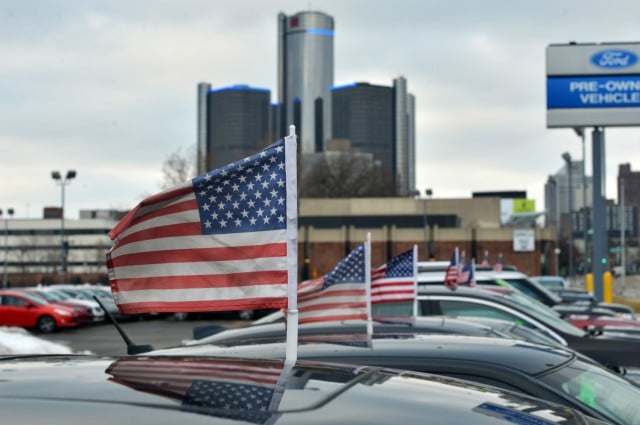I spent ten months in the US Bible Belt state of Kentucky when I was 17, studying at an All-American high school and living with American host parents – as well as a Slovakian host brother and five worryingly obese cats.
It was an incredible experience, including everything from a typical Kentucky horse race to planning how I would ask out a girl for Senior Prom (I ended up writing a cheesy poem).
But a few things really drove me crazy about America and Americans. When I returned to Germany at the end of the year, I noticed that other exchange students would fret about similar things.
Hitler jokes
When I told my English teacher on the first day of school that I was German, his joking response was: “Ms. Hill in the adjacent room is a Jew, maybe you should go talk to her.”
I was left speechless. Where I'm from, we still find it hard to talk about Germany's Nazi past – let alone make crude jokes about it.
But the Kentucky youth had a field day with the history of my country. People routinely raised their arms to a Hitler-salute as I was walking down the hallway – something which could be considered a criminal offence back home.
Whenever I’d get into debates with my friends, they would eventually shoot me down, saying ”Well, at least we didn’t exterminate all the Jews.”
American patriotism
 Flags of the U.S.A on cars in Detroit, Michigan. Photo: DPA
Flags of the U.S.A on cars in Detroit, Michigan. Photo: DPA
I always got a queasy feeling when my American friends fervently sang along to The Star-Spangled Banner at football games – I'm embarrassed enough when Germans wave the national flag during the World Cup season.
But not only that: the patriotism was often coupled with an ignorance about anything beyond the US borders.
This global blind spot mostly showed in history class. One time, while discussing the Second World War, a girl in one of the back rows raised her hand and asked: “So is Europe a place in Germany?”
Food frenzy
Nothing could have prepared me for the horror of a year without German baking.
I was used to crunchy-crusted, whole wheat German bread, so American white bread always left a gaping hole in my stomach. Desperate to fill the void, I developed a dangerous dependence on Reese's and chocolate-covered potato chips.
Within six months I put on an extra 10kgs (20 pounds). Luckily, I had picked up on the trend of buying extra-large T-shirts form Wallmart to cover up my growing pouch.
Where’s the public transport?!
 The art of hitch-hiking; Photo: picture-alliance/DPA
The art of hitch-hiking; Photo: picture-alliance/DPA
Making Europeans go without public transport is a bit like chopping off their legs.
The only bus I ever took in the US was the school bus from Monday through Friday (which apparently wasn’t built for students over a height of 1.80m).
Supposedly, there were two public transport buses that ran through the town of Frankfort every two hours, but my host parents said they were only used by people who didn’t have jobs. To this day, I have my doubts as to whether they actually existed.
Since my Slovakian host brother and I weren’t allowed to drive, we were usually stranded at my host parents' house.
Driven to desperation, my host brother once went for a two-kilometre-hike along the highway to get himself a Big Mac menu from the nearest McDonald’s.
Over-protective parents
My real parents' style of parenting had always been somewhat laissez-faire. At the age of 16, I was allowed to go clubbing until the early hours of the morning.
But not so in the US. My host parents were quick to ground me and would forbid everything that would cause them too much trouble. My host brother and I had to ask for permission every time we wanted to go out and were only allowed to meet someone they had approved of.
Needless to say, drinking alcohol and smoking weren’t permitted either.
To my 17-year-old self, staying with them was the closest I could get to prison without actually committing a crime.
Parties, drinking, and grinding
I also realized that not every country’s laws allow people to drink from the age of 16. As a result, many of my American friends simply drank alcohol in secret. And when they did, they hit the bottle like there was no tomorrow.
At parties, I would casually have a beer, while the people around me knocked back shots and cocktails. Within 20 minutes they were tripping and falling all over the place.
But “grinding” threw me off even more. Grinding is a dance style where girls rub their backsides on boys’ bodies while the boys just stand there trying to look cool. It's basically sex on the dance floor with your clothes on.
Jealous lovers
My ex-girlfriend from Kentucky was a sweet girl, but we had a few intercultural misunderstandings.
During the months that we were doing long-distance, I once went to a concert in Berlin with one of my best female friends. When my girlfriend found out, all hell broke loose.
We ended up in an intense Skype-fight and it took lots of apologizing and “never again's” to pick up the pieces.
But I was lucky. I had friends in Kentucky who ended relationships because their partners had “liked” the wrong person's picture on Facebook.
On a positive note…
Overall though, I had a great time in the US and, against all odds, Kentucky is a good place to live.
Unlike German Gymansien, American high schools have a vast range of clubs and associations, so I finally had the opportunity to figure out what I liked doing.
In ten months I had become part of the tennis team, the drama club, the marching band, the drumline, the academic team, the Beta club (another academic institution), and the writing club.
Most of all though, my stateside experience broke down one of the most stubborn stereotypes Germans hold about the people there: that Americans are superficial.
During my time in Kentucky, I got to know some of the most warm-hearted people I've ever met, and I made friends in no time. Almost everyone was exceptionally hospitable and caring and always up for a chat. If there's one thing I miss about the US, it's the people.



 Please whitelist us to continue reading.
Please whitelist us to continue reading.
Member comments